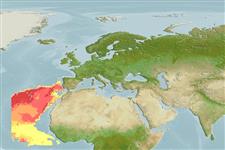>
Lophiiformes (Anglerfishes) >
Linophrynidae (Leftvents)
Etymology: Linophryne: Greek, 'linon' = flax or anything made of flax such as "cord," "rope," or a "net" + Greek, 'phryne' = "toad" (refers to a toadlike fish that fishes with a net) (Ref. 86949).
More on author: Regan.
Environment: milieu / climate zone / depth range / distribution range
Ecologia
marino batipelagico; non migratori; distribuzione batimetrica 1055 - 1295 m (Ref. 86949). Deep-water
Eastern Central Atlantic: off Madeira.
Size / Peso / Age
Maturity: Lm ? range ? - ? cm
Max length : 4.5 cm TL maschio/sesso non determinato; (Ref. 44404)
Short description
Chiavi di identificazione | Morfologia | Morfometria
Raggi dorsali molli (totale) : 3; Raggi anali molli: 3. Metamorphosed females distinguished by the following characteristics: escal bulb lacking distal prolongation; 2 distal filaments and a series of 5-8 branched filaments on each side; absence of anterior and posterior escal appendages; barbel divided at base into tiny filaments and single distal photophore; caudal peduncle with concentration of subdermal melanophores (Ref. 86949).
Only 1 female known. Males unknown (Ref. 13578).
Life cycle and mating behavior
Maturità | Riproduzione | Deposizione | Uova | Fecundity | Larve
Bertelsen, E., 1986. Linophrynidae. p. 1408-1414. In P.J.P. Whitehead, M.-L. Bauchot, J.C. Hureau, J. Nielsen, and E. Tortonese (eds.) Fishes of the North-eastern Atlantic and the Mediterranean. UNESCO, Paris, Vol. 3. (Ref. 13578)
IUCN Red List Status (Ref. 130435: Version 2024-1)
Threat to humans
Harmless
Human uses
Pesca: di nessun interesse
Strumenti
Special reports
Download XML
Fonti Internet
Estimates based on models
Preferred temperature (Ref.
123201): 2.4 - 2.9, mean 2.7 °C (based on 344 cells).
Phylogenetic diversity index (Ref.
82804): PD
50 = 0.5000 [Uniqueness, from 0.5 = low to 2.0 = high].
Bayesian length-weight: a=0.01995 (0.00906 - 0.04395), b=3.01 (2.83 - 3.19), in cm total length, based on all LWR estimates for this body shape (Ref.
93245).
Trophic level (Ref.
69278): 3.3 ±0.6 se; based on size and trophs of closest relatives
Fishing Vulnerability (Ref.
59153): Low vulnerability (10 of 100).
